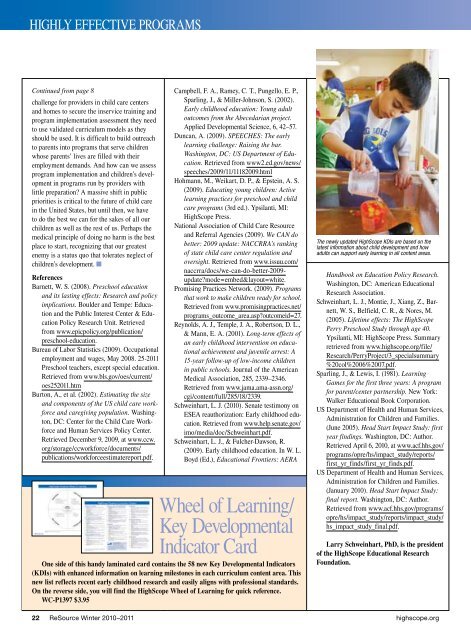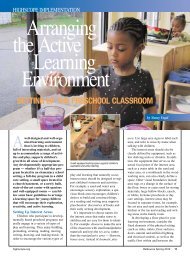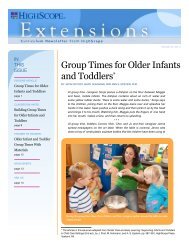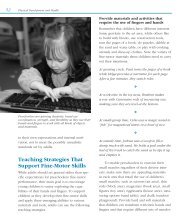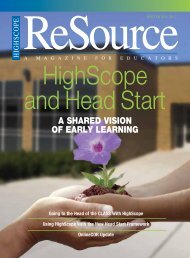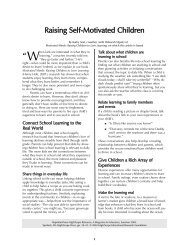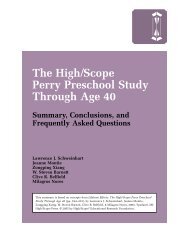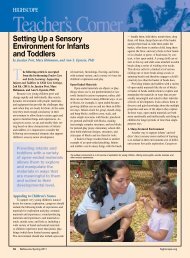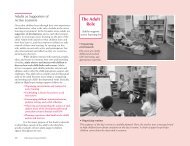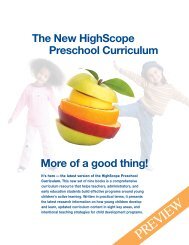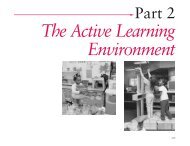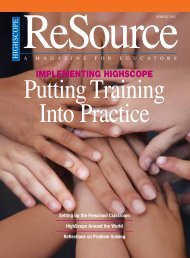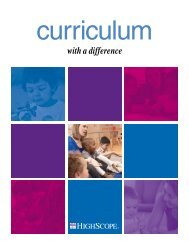DIVERSE AND INCLUSIVE CLASSROOM - High/Scope Educational ...
DIVERSE AND INCLUSIVE CLASSROOM - High/Scope Educational ...
DIVERSE AND INCLUSIVE CLASSROOM - High/Scope Educational ...
You also want an ePaper? Increase the reach of your titles
YUMPU automatically turns print PDFs into web optimized ePapers that Google loves.
HIgHLY EffECTIvE PROgRAmS<br />
Continued from page 8<br />
challenge for providers in child care centers<br />
and homes to secure the inservice training and<br />
program implementation assessment they need<br />
to use validated curriculum models as they<br />
should be used. It is difficult to build outreach<br />
to parents into programs that serve children<br />
whose parents’ lives are filled with their<br />
employment demands. And how can we assess<br />
program implementation and children’s development<br />
in programs run by providers with<br />
little preparation? A massive shift in public<br />
priorities is critical to the future of child care<br />
in the United States, but until then, we have<br />
to do the best we can for the sakes of all our<br />
children as well as the rest of us. Perhaps the<br />
medical principle of doing no harm is the best<br />
place to start, recognizing that our greatest<br />
enemy is a status quo that tolerates neglect of<br />
children’s development.<br />
References<br />
Barnett, W. S. (2008). Preschool education<br />
and its lasting effects: Research and policy<br />
implications. Boulder and Tempe: Education<br />
and the Public Interest Center & Education<br />
Policy Research Unit. Retrieved<br />
from www.epicpolicy.org/publication/<br />
preschool-education.<br />
Bureau of Labor Statistics (2009). Occupational<br />
employment and wages, may 2008. 25-2011<br />
Preschool teachers, except special education.<br />
Retrieved from www.bls.gov/oes/current/<br />
oes252011.htm<br />
Burton, A., et al. (2002). Estimating the size<br />
and components of the US child care workforce<br />
and caregiving population. Washington,<br />
DC: Center for the Child Care Workforce<br />
and Human Services Policy Center.<br />
Retrieved December 9, 2009, at www.ccw.<br />
org/storage/ccworkforce/documents/<br />
publications/workforceestimatereport.pdf.<br />
Campbell, f. A., Ramey, C. T., Pungello, E. P.,<br />
Sparling, J., & miller-Johnson, S. (2002).<br />
Early childhood education: Young adult<br />
outcomes from the Abecedarian project.<br />
Applied Developmental Science, 6, 42–57.<br />
Duncan, A. (2009). SPEECHES: The early<br />
learning challenge: Raising the bar.<br />
Washington, DC: US Department of Education.<br />
Retrieved from www2.ed.gov/news/<br />
speeches/2009/11/11182009.html<br />
Hohmann, m., Weikart, D. P., & Epstein, A. S.<br />
(2009). Educating young children: Active<br />
learning practices for preschool and child<br />
care programs (3rd ed.). Ypsilanti, mI:<br />
<strong>High</strong><strong>Scope</strong> Press.<br />
national Association of Child Care Resource<br />
and Referral Agencies (2009). We CAN do<br />
better: 2009 update: NACCRRA’s ranking<br />
of state child care center regulation and<br />
oversight. Retrieved from www.issuu.com/<br />
naccrra/docs/we-can-do-better-2009update?mode=embed&layout=white.<br />
Promising Practices network. (2009). Programs<br />
that work to make children ready for school.<br />
Retrieved from www.promisingpractices.net/<br />
programs_outcome_area.asp?outcomeid=27.<br />
Reynolds, A. J., Temple, J. A., Robertson, D. L.,<br />
& mann, E. A. (2001). Long-term effects of<br />
an early childhood intervention on educational<br />
achievement and juvenile arrest: A<br />
15-year follow-up of low-income children<br />
in public schools. Journal of the American<br />
medical Association, 285, 2339–2346.<br />
Retrieved from www.jama.ama-assn.org/<br />
cgi/content/full/285/18/2339.<br />
Schweinhart, L. J. (2010). Senate testimony on<br />
ESEA reauthorization: Early childhood education.<br />
Retrieved from www.help.senate.gov/<br />
imo/media/doc/Schweinhart.pdf.<br />
Schweinhart, L. J., & fulcher-Dawson, R.<br />
(2009). Early childhood education. In W. L.<br />
Boyd (Ed.), <strong>Educational</strong> Frontiers: AERA<br />
Wheel of Learning/<br />
Key Developmental<br />
Indicator Card<br />
One side of this handy laminated card contains the 58 new Key Developmental Indicators<br />
(KDIs) with enhanced information on learning milestones in each curriculum content area. This<br />
new list reflects recent early childhood research and easily aligns with professional standards.<br />
On the reverse side, you will find the <strong>High</strong><strong>Scope</strong> Wheel of Learning for quick reference.<br />
WC-P1397 $3.95<br />
The newly updated <strong>High</strong><strong>Scope</strong> KDIs are based on the<br />
latest information about child development and how<br />
adults can support early learning in all content areas.<br />
Handbook on Education Policy Research.<br />
Washington, DC: American <strong>Educational</strong><br />
Research Association.<br />
Schweinhart, L. J., montie, J., Xiang, Z., Barnett,<br />
W. S., Belfield, C. R., & nores, m.<br />
(2005). Lifetime effects: The <strong>High</strong><strong>Scope</strong><br />
Perry Preschool Study through age 40.<br />
Ypsilanti, mI: <strong>High</strong><strong>Scope</strong> Press. Summary<br />
retrieved from www.highscope.org/file/<br />
Research/PerryProject/3_specialsummary<br />
%20col%2006%2007.pdf.<br />
Sparling, J., & Lewis, I. (1981). Learning<br />
Games for the first three years: A program<br />
for parent/center partnership. new York:<br />
Walker <strong>Educational</strong> Book Corporation.<br />
US Department of Health and Human Services,<br />
Administration for Children and families.<br />
(June 2005). Head Start Impact Study: first<br />
year findings. Washington, DC: Author.<br />
Retrieved April 6, 2010, at www.acf.hhs.gov/<br />
programs/opre/hs/impact_study/reports/<br />
first_yr_finds/first_yr_finds.pdf.<br />
US Department of Health and Human Services,<br />
Administration for Children and families.<br />
(January 2010). Head Start Impact Study:<br />
final report. Washington, DC: Author.<br />
Retrieved from www.acf.hhs.gov/programs/<br />
opre/hs/impact_study/reports/impact_study/<br />
hs_impact_study_final.pdf.<br />
Larry Schweinhart, PhD, is the president<br />
of the <strong>High</strong><strong>Scope</strong> <strong>Educational</strong> Research<br />
Foundation.<br />
22 ReSource Winter 2010–2011 highscope.org


